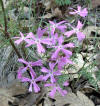|
Phlox austromontana
|
Phlox austromontana
|
|
Phlox austromontana Nevada. Toiyabe Range. South of Austin along Robinson Creek, 4x4 road to Birch Creek Ranch, which is at junction with Road 376, ~3.5 mi south of Frontier, Hwy 50. 10 July 2009 |
Phlox diffusa |
|
Phlox diffusa
|
Phlox gladiformis
|
|
Phlox longifolia
|
Phlox
hoodii
|
|
Phlox
pulvinata
|
Phlox speciosa
|
|
Phlox stansburyi |
Phlox stansburyi
|
|
Trees and Shrubs of Kern County (Jan 2013, Jan 2014) Phlox. Annuals, perennials or subshrubs; leaves simple, crowded along the stems or in subshrub species often clustered near apex; flowers terminal, generally single (from reduced cymes); stamens inserted at different levels in the corolla tube; valves of capsule deciduous. ±50 species, mostly western North America, also northern Asia. 1. Leaves soft, flexuous, not sharp at tip............................................. Phlox stansburyi 1. Leaves rigid, needle-like, ending in a sharp point.........................................................2
2. Calyx flat more than rib-like, not keeled near base; calyx tube with
2.
Calyx rib-like or keeled, especially near base; calyx tube not
Phlox austromontana Coville 1893. Desert Phlox. Generally matted perennial with woody stems near base, to 10 cm; leaves sword-shaped, 5–7x longer than wide, 0.8–2 cm long, gradually narrowed to apex and usually with a short hyaline needle-like extension (apiculus); flowers Apr–Jun, usually white, less often pink or pale blue, (8-)11–15 mm. Generally in partially shaded understory of open montane pine forests; Great Basin Desert from Colorado west to central Oregon, south at scattered locations along Sierra Nevada to northern Baja California, also Arizona. Type from Beaver Dam Mts., Washington Co. Utah. Kern Co.: “Colonies are scarce in the rocks along the crest of Piute Mountains” [Twisselmann, var. subcarinata with reference to P. douglasii), 2287–2502 m (CCH). Also reported by C. Millar and T. Keeler-Wolf from the Long Canyon Natural Research Natural Area. Phlox diffusa Bentham 1870 [includes ssp. subcarinata Wherry 1939]. White Phlox. Generally matted perennial with woody stems near base, to 10 cm; leaves sword-shaped, 5–7x longer than wide, 0.5–2 cm long, gradually narrowed to apex; flowers May–Aug, white to pink or pale blue, 9–17 mm. Generally in partially shaded understory of open montane pine forests, western U.S. and southwestern British Columbia. Type from near Bear Valley in the Sacramento Mts., Calif. Kern Co.: “A matted plant of exposed high elevations that grows in colorful drifts on the broad open summit plateau of Mt. Pinos. Colonies are scarce in the rocks along the crest of Piute Mountains” [Twisselmann, var. subcarinata with reference to P. douglasii, which is interpreted here as P. austromontana), 2287–2502 m (CCH). Phlox stansburyi (Phlox speciosa Pursh 1814 f. stansburyi Torrey 1859) Heller 1897 var. superba (Phlox superba A. Brand 1907) Wherry 1942. Stanbury’s Phlox. Perennial, compact, often branched below ground, to 40 cm high; flowers Apr–Jun, pink to white, 17–25 mm; disturbed roadside, Pinyon-Juniper woodland, Great Basin Desert, 1700–3000 m. Type from Tonopah, Nye Co., Nevada. Kern Co.: 1.9 miles east of the summit of Walker Pass (Raven, 03 May 1958, CCH).
|
|












